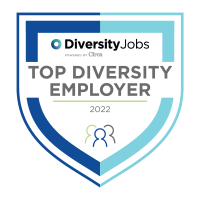Diversity, Equity and Inclusion (DE&I)

DiversityJobs.com Top Diversity Employer
SIRVA Is pleased to announce that we have been named a Top Diversity Employer by DiversityJobs.com. This award was given to a select group of employers that have shown consistent dedication to recruiting and hiring from all diversity groups.
Useful Resources
SIRVA’s Commitment/Mission Statement
At SIRVA, we’re committed to cultivating a workplace and an ecosystem that reflects the diversity of the global organisations that we serve. We recognise that building an inclusive, engaged company culture results in empowered employees that reflect a wide range of approaches and perspectives. Those perspectives lead to new ideas. New ideas lead to innovation and excellence. Our approach to diversity, equity and inclusion is driven by a commitment to these values and a belief that diversity makes our company stronger.

Ricky Aow
Sales & Account Management Business Analyst (Victoria, Australia)
This industry attracts passionate, down-to-earth people from diverse backgrounds, many of which who have been in the industry for 10, 20, 30+ years. I have a marvellous manager, who regularly takes time to update me, I enjoy the flexibility and challenges of the work. The business leaders are personally invested, dedicated, and bring energy and commitment to the team. Recently I was chuffed when a leader from a different business unit nominated me for a STAR award. The thing I treasure the most is the friendships I have made at SIRVA; friendships and memories that I will cherish
SIRVA's Employee Resource Groups (ERGs)
ERGs are employee-led, self-directed voluntary groups that offer opportunities to network internally, to attract a diverse employee base, to provide the inclusion of ideas and solutions, and to create opportunities for mentoring and career development.
SIRVA is proud to announce the formation of our first two Employee Resource Groups!

DEN –The Diverse Employee Network (People of Colour)
Mission: SIRVA People of Colour Employee Resource Group (ERG) is open to all employees. The ERG aims to advance a diverse and inclusive work environment with a particular focus on people of colour. Working with a dedicated network of diverse professionals, the ERG undertakes activities to attract, retain, empower and inspire employees of colour. These efforts are geared toward helping members gain leadership experience, get involved in the SIRVA community and develop new ideas to help drive SIRVA forward.
 SOL – SIRVA Out Loud (LGBTQ+)
SOL – SIRVA Out Loud (LGBTQ+)
Mission: Our mission is to create a safe and supportive space for LGBTQ+ SIRVA team members and their allies to thrive and be celebrated, so that we can provide advocacy for equity and an inclusive experience in all settings.

Recruiting & Outreach

- Internships
- Recruiting
- Partnerships
- Corporate Presence
Organisational Development

- Engagement
- Performance
- Promotions
- Pay Equity
Mentorship

- Career Development
- Interest Groups
Education & Training

- New Hire Onboarding
- Inclusiveness
- Standards & Training

Harriet Kwawukume
Client Finance Team Lead (Prague, Czech Republic)
“Being part of the SIRVA family has been a marvellous experience in my career growth. Having joined the finance team and getting to encounter the diverse multicultural environment has been great. SIRVA helped me to develop as an Analyst by investing in my skills and potential and bringing out the best in me and I’m currently leading one of the teams in finance. I foresee an empowering future here and I look forward to it!”
Mobilising Diversity: Customer Stories
Building and Leading Equitable and Inclusive Talent Management
Diversity, equity and inclusion (DE&I) is ever-evolving. There is no one-size-fits-all approach. In this three-part series, you will hear from three of our clients (Kia Engines, Ardent Mills and HPE). Our clients all have expertise in mobility and are helping change the landscape for DE&I efforts; they will share their stories as an effort to help other organisations learn from peers on how DE&I intersects with mobility and talent management.
Domestic Relocation Best Practices
Aligning Business Needs, Employee Experience, and Country Nuances
In the current COVID-19 climate, domestic relocation has become a significant driver behind mobility due to a focus on local talent sourcing, cost containment, and international travel restrictions. While domestic relocation may seem less costly and, as such, less stressful to manage than an international relocation, organisations continue to grapple with the complexities and challenges of domestic relocation, whether a multinational company based in Asia Pacific (APAC), a global company based in Europe, or an American company with offices in the Middle East. With significantly disparate costs of living, cultural differences, a lack of well-defined policies, and/or a lack of host-country domestic knowledge due to a centralised mobility programme, companies may struggle to find the right candidates and to align employee experience with business needs.
There are two critical actions that global mobility practitioners or human resource professionals need to take before designing an effective domestic relocation programme. The first is consultation with the business to understand organisational needs and required talent skillsets. The second is benchmarking existing relocation strategies with competition in the same industry and region to ensure the attractiveness of the relocation package. Once the first two are achieved, the process of designing a domestic relocation programme that incorporates policies, processes, and service delivery models will be far more constructive and efficient.
 1. Consultation and Alignment with Business
1. Consultation and Alignment with Business
Organisations often seek to define talent needs on a company-wide basis, rather than considering local business unit needs. At SIRVA, we find that organisational growth and workforce deployment are typically ranked as top organisational priorities in surveys that consider the overall success of organisations. Therefore, it is important for global mobility teams to consult with internal departments to understand:
- The business goals that are that are driving each relocation
- Which key strategic roles are required
- Key skillsets that are required for each role
- How a successful relocation will be defined
As with many organisational structures, global mobility could be managed in two ways: a centralised structure (which is managed from a single location – often from the organisation’s headquarters) or a decentralised structure (with decision makers in multiple locations/regions). If utilising a centralised structure, global mobility teams face the challenge of being aware of cultural and geographical differences in varying countries (and locations within those countries) that could impact mobility.
In an intra-India move, the country’s broad ethnic and linguistic diversity, and differences in educational structures and housing practices can make an employee feel as though s/he is relocating to a completely different country.
For instance, while some destination services may not be needed for an intra-country move within the United States, they may very well be needed in an intra-India move, as the country’s broad ethnic and linguistic diversity, and differences in educational structures and housing practices can make an employee feel as though s/he is relocating to a completely different country. There is no one-size-fits-all solution for any intra-country relocation, thus it is important to consider:
- Perception of the relocation programme: Perceptions of relocation (how it should be defined, what it should consist of, and the level of support provided) can vary from country to country, so it is important to understand regional and cultural norms and expectations – along with company and employee goals and expectations.
- The interest level of local talent: If the new location presents significant challenges for or changes to employees – regarding cost of living, housing availability, access to amenities, or security risks – organisations may need to consider enticing employees with increased relocation support or compensation.
- Relationships with local stakeholders:If utilising a centralised mobility management structure, it is particularly important to define and formalise clear roles and responsibilities with global teams, utilise local expertise, and identify any potential challenges.
- Decision-maker buy-in: Particularly important if utilising a centralised management model, securing localised stakeholder support of and adherence to the mobility programme framework helps to ensure that processes run more smoothly. By incorporating local expertise when planning the mobility programme, stakeholder buy-in is more readily obtained and troubleshooting ahead of time can be achieved, versus the need for reactive responses to challenges after they’ve already occurred.
2. Relocation Benefits Benchmark
 Benchmarking a domestic relocation programme is a good way to assess how it stacks up against other organisations and is also a critical step in identifying what relocation strategies work best for varying desired talent profiles. A set of benchmarking metrics can be established by considering:
Benchmarking a domestic relocation programme is a good way to assess how it stacks up against other organisations and is also a critical step in identifying what relocation strategies work best for varying desired talent profiles. A set of benchmarking metrics can be established by considering:
- Best practices and average cost benefits
- Competitors within the same industry
- Companies with a comparable number of annual relocations
When working with a relocation management company (RMC) to establish benchmarking metrics, clients benefit from that provider’s years of experience and knowledge regarding the nuances of varying global locations. For example, there is a vast difference when comparing a Chinese multinational company’s (MNC’s) domestic programme to another country’s relocation benefits. In China, access to reputable public schools is dependent on an employee’s hukou system and municipal residency, which would be a critical element to consider when domestically relocating an employee from a third-tier city to a first-tier city, or vice versa. These regional nuances exist regarding mobility components in many countries; RMCs with a wide global reach and extensive experience can offer valuable guidance on the differences – and innovative solutions – when benchmarking standards must be met.
There is a vast difference when comparing a Chinese multinational company’s (MNC’s) domestic programme to another country’s relocation benefits. In China, access to reputable public schools is dependent on an employee’s hukou system and municipal residency, which would be a critical element to consider when domestically relocating an employee from a third-tier city to a first-tier city, or vice versa.
Domestic Relocation Programme Design
The design of domestic relocation programmes incorporates policies and processes that support a range of move types. A successful programme should address both the needs of the business and the relocating employee by including flexibility in the nature, level, and delivery of support. There are many ways to address flexibility; one way includes leveraging a core-flex mobility programme for a domestic relocation, which includes flexible components in conjunction with a core set of services that are provided to all employees within a group or move type. As one example, a global company, which has a decentralised mobility team in India, created a domestic policy that allows employees to choose between temporary living (15-30 days) or a security deposit after identifying that different employee profiles preferred different accommodation benefits. This flexible component has proven not only to improve the employee experience but also to strengthen talent retention.
Areas to consider during the design phase include:
- Identifying criteria for service differentiation, such as grade level, family size, and talent scarcity on location
- Assessing potential relocation challenges for a particular assignee or origin/destination (e.g. in India, rental properties are not centrally listed and the market moves extremely fast, making destination services support critical to navigating the home-finding process quickly; in Germany, new property addresses must be registered within 14 days to be compliant with tax authorities).
 Clarifying who is responsible for any tax liability:Year-end tax reporting and how to capture all associated costs related to the transfer is important even for domestic transfers, as in most jurisdictions relocation support is deemed a benefit in kind and is subject to employment tax rules.In the UK, there can be tax relief for the employee on the first £8,000 of eligible relocation benefits. For small or moderate move types, companies have taken to giving a lump sum of £8,000 to company-sponsored transfers.Unless detailed reporting is captured for this amount through P11D and PSA reporting, the whole amount could attract full tax liability as only eligible expenses fall within the exemption, so careful thought needs to be given as to how all relocation costs are monitored and captured, including sundry employee expenses. End-of-year reporting is a key requirement for domestic moves, as is guidance in policy regarding who will be responsible for bearing the cost of any tax liability.
Clarifying who is responsible for any tax liability:Year-end tax reporting and how to capture all associated costs related to the transfer is important even for domestic transfers, as in most jurisdictions relocation support is deemed a benefit in kind and is subject to employment tax rules.In the UK, there can be tax relief for the employee on the first £8,000 of eligible relocation benefits. For small or moderate move types, companies have taken to giving a lump sum of £8,000 to company-sponsored transfers.Unless detailed reporting is captured for this amount through P11D and PSA reporting, the whole amount could attract full tax liability as only eligible expenses fall within the exemption, so careful thought needs to be given as to how all relocation costs are monitored and captured, including sundry employee expenses. End-of-year reporting is a key requirement for domestic moves, as is guidance in policy regarding who will be responsible for bearing the cost of any tax liability.- Building a policy framework with flexibility to remove barriers to relocation
A Need for Domestic Move Support
Business growth and a lack of readily available talent in some locations has resulted in the emergence of domestic assignments as a talent recruitment strategy; this is often a challenging task for mobility teams who are required to attract and retain local talent in an especially short span of time. For instance, a global company with a centrally managed mobility function in the United States faced the difficult task of retaining talent and providing adequate relocation support when moving an office from Shanghai to Beijing. SIRVA became the extension of the central mobility team, providing an objective consultation on policy elements that were needed for talent retention, as well as the market benchmarking of relocation benefits and insights into hukou application and fapiao. Eventually, critical roles were retained; area orientation and settling-in services were also delivered through creative solutions in a timely manner amid the coronavirus pandemic.
From business consultation and policy benchmarking to aligning processes and implementation, an experienced RMC can be an extension of an organisation’s internal team, providing years of expertise and country specific, in-depth knowledge that fosters flexibility and agility. For organisations with a centralised mobility team, an RMC can provide local expertise, globally, to ensure that mobility programmes are aligned with local nuances. For those with decentralised mobility teams, having a single point of contact with a relocation expert will be essential to support smooth domestic relocations.
For more information on how SIRVA can assist your company with domestic/intra-country relocations, contact us at concierge@sirva.com.
Contributors:
Jialin Chia, Marketing Manager, Asia and Middle East, SIRVA
Dinalie Kalpage, Senior Regional Marketing Manager, APAC and Middle East
Lisa Marie DeSanto, Content Marketing Manager





